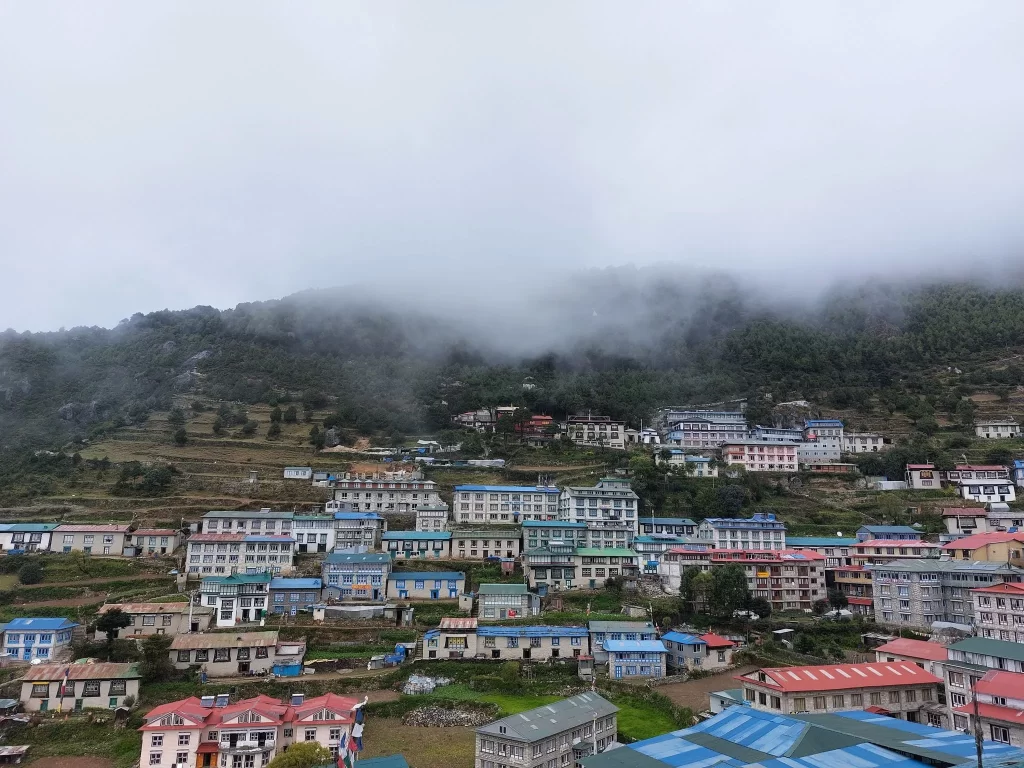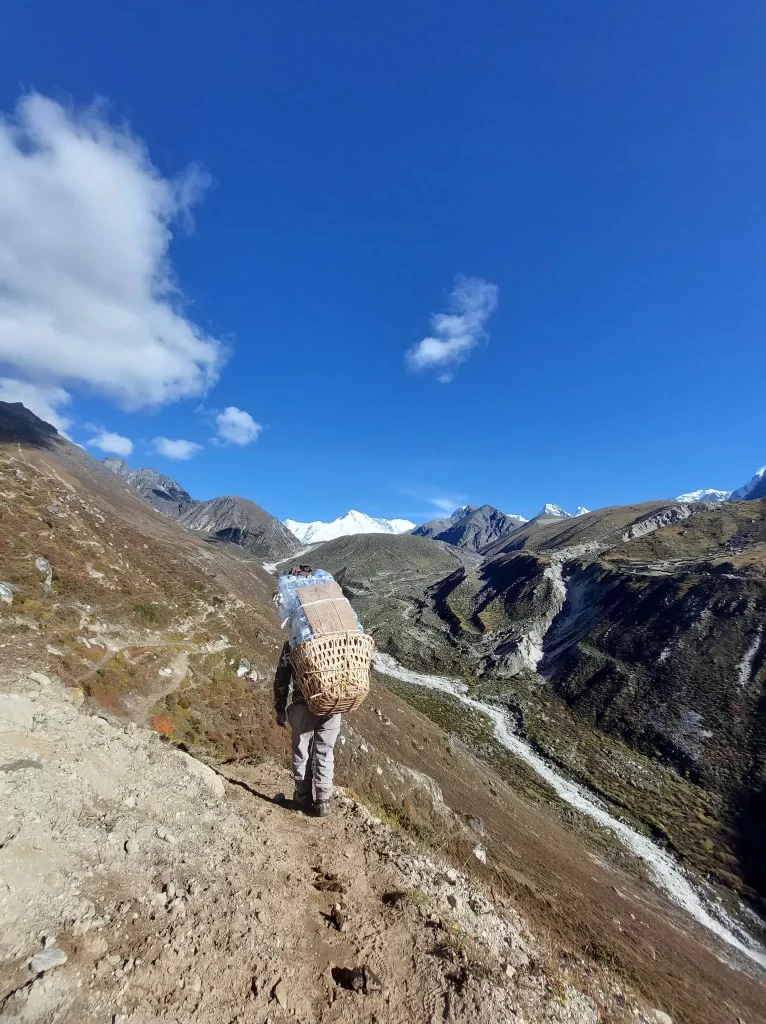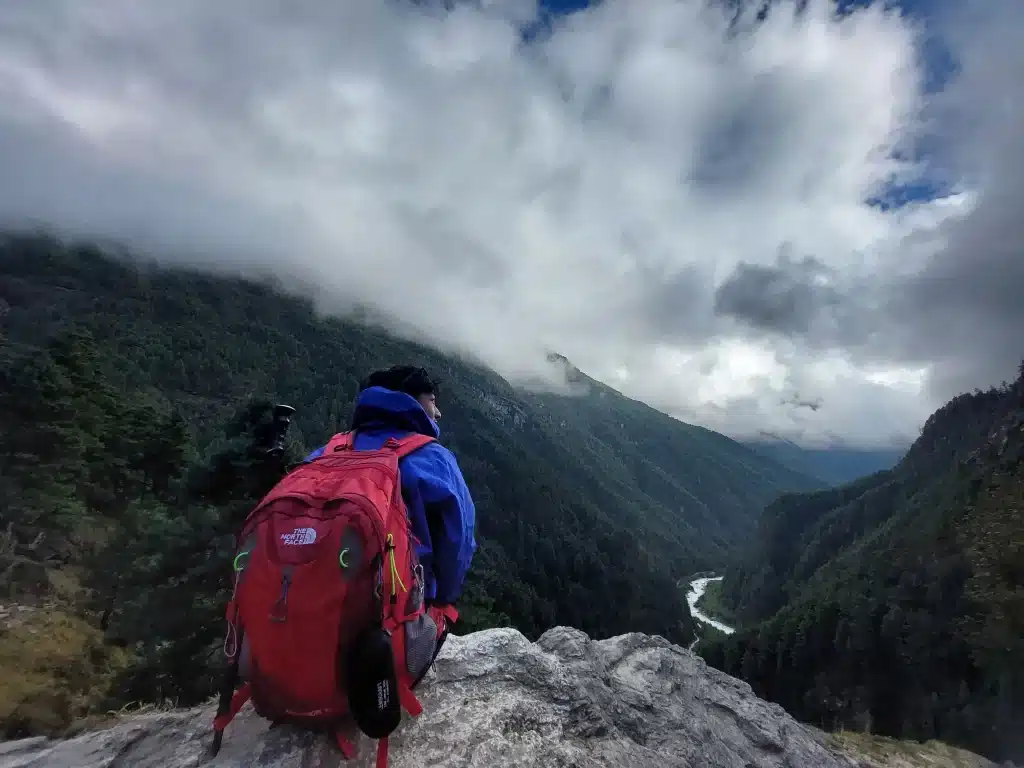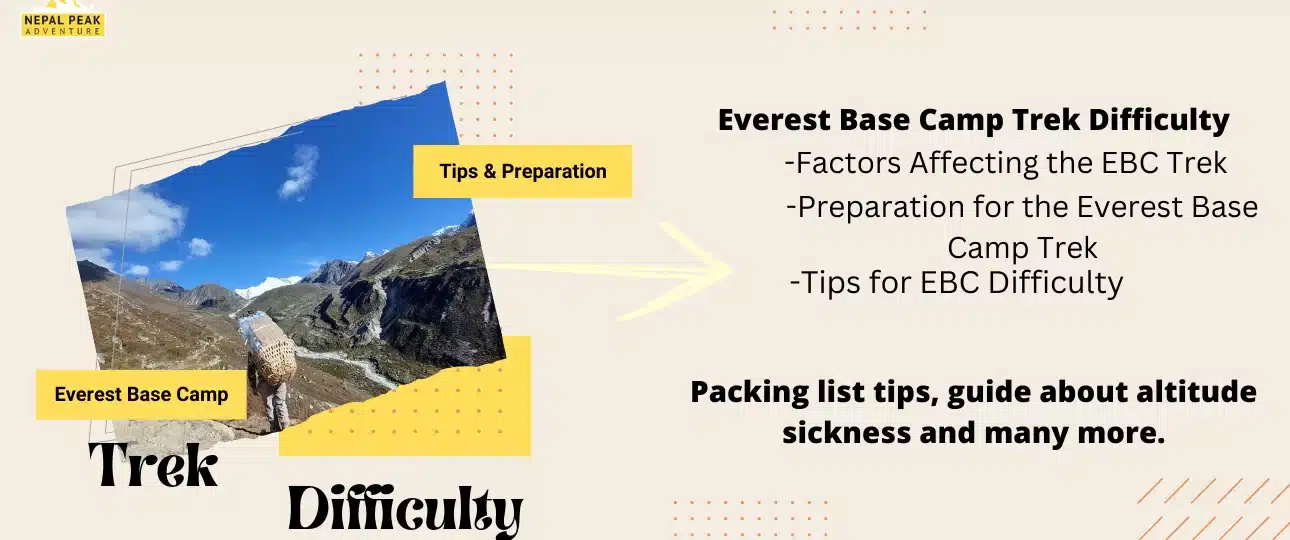Exploring the Everest Base Camp Trek Difficulty
In this guide, we will provide a detailed overview of the Everest Base Camp Trek Difficulty, including the factors, information about altitude sickness, guidance, and some tips. As we all know, Everest Base Camp Trek is a challenging adventure, with some pro tips, you will be ready to embark on this beautiful journey one day.
Table of Contents
Introduction
About Everest Base Camp Trek
After the first successful ascent to Mount Everest by Sir Edmund Hillary & Tenzing Norgay Sherpa in 1953, the achievement marked the beginning of modern mountaineering in this region.
People around the world begin to attempt to summit the world’s tallest mountain Mt. Everest every year. Similarly, to support the need of the mountaineers, infrastructure grew slowly, including the trails, lodges, tea houses, & supplies.
Over time, expeditions & trekking became popular activities, as people from all over the world got the chance to experience the natural beauty & culture.
Today, Everest Base Camp Trek is one of the famous trekking trails that draws thousands of trekkers each year. However, despite its popularity, the trek to Base Camp remains a challenging adventure as lots of factors affect the Everest Base Camp Trek Difficulty.
Understanding the Difficulty of the Everest Base Camp Trek

Why this trek is challenging because, the Everest Base Camp Trek covers a distance of 130km (80.7 miles) round trip, with an elevation gain of over 5,545m.
It is expected to trek for 6-7 hours per day on average, with some days being longer & more strenuous than other days.
Trekking at a high altitude can cause dehydration, frostbite, altitude sickness & other problems. However, it can be tackled with proper preparation & research. Similarly, the terrains are rugged & steep with a chance of facing snow or rain while trekking.
Despite all those difficulties, the Everest Base Camp trek is very rewarding, worth it, & adventurous with a chance to interact with the culture of the Sherpa people.
Factors Affecting the Everest Base Camp Trek Difficulty
Altitude Sickness
There is three altitude illness Acute Mountain Sickness (ACE), High-Altitude Cerebral Edema (HACE), & High-Altitude Pulmonary Edema (HAPE).
Acute Mountain Sickness (AMS) is the mildest form of altitude illness that occurs when hiking or traveling at a high altitude above 2,400m with low oxygen levels, such as EBC.
High-Altitude Cerebral Edema (HACE) & High-Altitude Pulmonary Edema (HAPE) are caused by fluid accumulation in the brain or lungs, which are life-threatening forms of altitude illness.
Among these three altitude illnesses, AMS is a common illness that people suffer when trekking at Everest Base Camp.
Symptoms like sudden headaches, dizziness, nausea, fatigue, extreme tiredness, or difficulty sleeping may appear during AMS. However, AMS resolve on their own within a day or two after following acclimatization, taking medicine, or descending to a lower altitude.
As a number one factor for Everest Base Camp Trek Difficulty, you need to be more concerned about altitude sickness.
How does Altitude Sickness affect the trek?

Altitude sickness affects the trekker’s ability to walk & leads to serious health complications if left untreated.
Normally, the average duration to complete the trek is 12-14 days with an acclimatization day on it. However, if you suffer from AMS, you will need extra days to recover which will make the trek a little longer.
Similarly, during altitude illness, the walking pace will be slow which will consume more energy & time to complete the trek.
Preventive Measures to Avoid Altitude Sickness:
With proper treatment, AMS can be cured easily & with proper preparation, you can avoid AMS too.
Some of the preventive measures to Avoid Altitude Sickness are:
- Taking Proper Acclimatization Day:
Sudden gain of altitude is the root cause of AMS, which is why proper acclimatization is crucial for the body. Acclimatizing helps the body to adjust to the lower oxygen levels at higher altitudes. - Ascend Slowly:
Ascending to higher altitude itself is a challenging activity & ascending too fast is the biggest mistake that trekkers do to show off their strength. You may not realize the consequences, but sooner or later, you will get AMS if you do not ascend slowly. - Eating Properly in Tea Houses:
Nutrition is essential to maintain energy to help you trek to another destination. As there will be no shops or store on the trail, your main fuel will be breakfast & lunch in tea houses. With a properly balanced diet, you will never feel hungry in the middle of the road. - Staying Hydrated:
The main preventive measure to avoid altitude sickness is by staying hydrated all the time. Take lots of hydration tablets & water purifiers to have clean water. Also, drink plenty of fluid, in the form of water, tea, soups, or another way.
Length and duration of the trek
Another factor that affects the trekking difficulty of Everest Base Camp is length & duration also known as itinerary.
The average days to complete the Everest Base Camp trek requires 12-14 days. However, the weather & walking pace also affects the duration of the trek which results in longer days.
Starting from Lukla village, the trek continues to Everest Base Camp with a day-to-day 6-8 hours of walking. It will be a challenging trek where some days will be longer and harder than others days.
Overall, trekkers should be aware as well as prepare for the length & duration required for the EBC trek. Following a planned trek to ensure a safe is what you will need to overcome this number 2 factor for difficulty.
Different long and short itineraries to complete the Everest Base Camp Trek
As mentioned earlier, the itinerary for the EBC trek can vary according to itineraries and it also impacts the overall experience of the trek.
A long itinerary spans about 16-20 days which can include either extra acclimatization days to adjust to altitude or new locations to enjoy more.
Long Itineraries with acclimatization & rest days also allow trekkers to explore the surrounding areas more while having a high chance of success rate.
On the other hand, adding new locations to complete the EBC trek, for example, EBC via Gokyo Lake trek, and Three Passes Trek are long itinerary packages. This kind of package is challenging & suitable for experienced trekkers who are comfortable with high altitudes.
Short itineraries span around 10-12 days which is beneficial for trekkers who are well-experienced & have limited time. Similarly, the short itinerary for the EBC trek is less expensive with limited rest days.
Best Itinerary to Choose according to Everest Base Camp Trek Difficulty
Various factors like trekkers’ experience level, fitness level, & time constraints decide what itinerary is best for trekking at Everest Base Camp.
For beginners or starters, a 14-16 Days itinerary is recommended which will have a minimum of 2-3 days of acclimatization day. 14-16 Days duration also reduces the risk of altitude sickness which is the major factor for difficulty.
In my opinion, the best itinerary to choose for Everest Base Camp Trek is 14-16 Days. The reason is the high success rate & hassle-free where I can enjoy the surrounding & trek slowly.
Similarly, note that the 14-16 Days itinerary is the normal package that takes you to EBC which does not include any Gokyo Lake or High-Passes Trek.
For experienced trekkers, who have prior experience in high-altitude trekking, a short itinerary of 10-12 days may be suitable. However, it will still be a challenging trek & require good physical fitness. A good reason to choose the short itinerary is to minimize cost & save time.
In conclusion, the best itinerary depends upon the trekker’s experience, fitness level, & time constraints.
Weather Conditions

Due to the high altitude & location, there are expected of extreme weather conditions can have a significant impact on the Everest Base Camp Trek difficulty.
Even during the Autumn season & Spring seasons, which are the peak season & considered the best time for trekking, also have unpredictable weather conditions. However, getting bad weather during this time is very rare.
Weather conditions such as snowfall, rain, and foggy atmosphere are some examples that make trekking difficult.
During Monsoons & Winter, it is nearly impossible to trek due to extreme weather conditions. Even though some trekkers make it during monsoons & winter, not everyone will have the same luck & weather to complete the trek normally.
Trekkers should plan their trekking in the best seasons like Autumn & Spring while having flexible dates to counter extra stay in tea houses.
You can also ask professionals like us for the best time & tips to plan the trek anytime.
How to predict the weather during Everest Base Camp Trek?
Predicting the weather in Everest Base Camp can be very challenging due to the unpredictable nature of high altitudes. However, there are some useful techniques that can help trekkers to anticipate the weather & prepare accordingly.
- Consult with Local Guides or Tea houses: Local guides have many experiences in that area and can provide valuable insights into the weather patterns in the region. They can also tell whether you will be able to trek in bad weather or not too.
- Check Weather Forecast on Mobile: There are many apps that will provide you with up-to-date weather information. Check the weather before leaving for the trek so that you can prepare ahead of time.
- Observing the Sky: Observing the sky can also provide important indications about the weather. Watch for clouds that may indicate the possibility of rain & snow or foggy weather.
Terrain and Trail Difficulty
The route to Everest Base Camp is not a well-paved or straight road, instead, it is steep ascent & descent with narrow bridges, narrow roads, rocky paths, snowy paths, ice paths, & high passes.
Terrain & Trail are other factors that affect the Everest Base Camp Trek difficulty which new trekkers are not well known.
Depending upon the fitness level & experience, terrain & trails do matter while trekking. While preparing for the Everest Base Camp trek, trekkers need to carefully consider this factor.
How you should prepare for the Everest Base Camp Trek Difficulty
Moderate-level Training and Exercise
Training & Exercise are most crucial for preparing to do Everest Base Camp Trek. You will need a moderate level of training which includes, cardiovascular training, endurance training, strength training, high altitude training, and mental preparation.
Outdoor exercise or activities like hiking & cycling are very important and the best way to prepare for the trek. Other exercise/training can be done by creating a workout plan that a gym trainer can make for you.
The most important of all the exercises that you need to do is altitude training so that you can trek above 5,000m altitude like Everest Base Camp.
The best way to do altitude training is by hiking to a higher elevation so that you can find and adjust your body to the elevation. You should do this activity twice in a week if possible and above 2,500m altitude.
However, if there is no place to hike then you can focus on breathing control techniques & stamina building. Consult with your trainer if possible otherwise, another method you can apply is by doing hill repeats & stair climbing techniques.
Hill repeats means, repeating running or hiking up a steep hill multiple times in a row under 2,000 elevation. Whereas, stair climbing technique means climbing the stairs multiple times while slightly increasing the intensity.
Overall, the main goal of doing physical training is to adapt to the higher altitude while walking 6-7 hours per day. Even though it may seem hard, you can do it with the right techniques and guidance. Please, do not approach without training as it can get dangerous.
Packing Proper Gear & Equipment
Proper Gear & Equipment are crucial when trekking in Everest Base Camp as they lower the chance of getting cold, altitude sickness, dehydration, injuries, and other things.
Similarly, the main purpose of packing proper gear & equipment is to have a safe & sustainable trek above 3,000m altitude. As the temperature drops above 3,000m altitude, the weather is unpredictable and requires different clothes & gears to march forward.
While packing gears, pack clothes in layers that should be moisture-wicking properties, polyester, nylon, or merino materials. Waterproof and Windproof jacket is also compulsory in the high Himalayas.
Other key factors that you need to look for in your clothing are:
- The clothing layers that you pack should be breathable.
- Sun protection clothing with full sleeve T-Shirts.
- Clothes that absorb moisture.
- Insulating properties of clothes that will keep you warm.
Trekkers should also bring trekking boots, hiking sandals, & thicker/thinner socks. It is important to bring the full boot that you are comfortable with, that also protects your ankle & gives support.
Invest in quality that has high durability, is productive, and is important for trekking.
Conclusion
Recap of the factors that affect the difficulty of the EBC trek
In conclusion, even though the Everest Base Camp trek is a challenging trek & many factors affect the difficulty level, it is possible to trek with the right preparation. It is important to research factors like altitude sickness, length & duration, weather conditions & terrain & trail difficulty and take preventive measures.
To undertake the trek successfully, you also need to have proper gear & equipment, the right workout, and guidance to have a safe & sustainable trek. Remember that the Everset Base Camp Trek difficulty depends upon you because if you work hard then you will achieve it.



